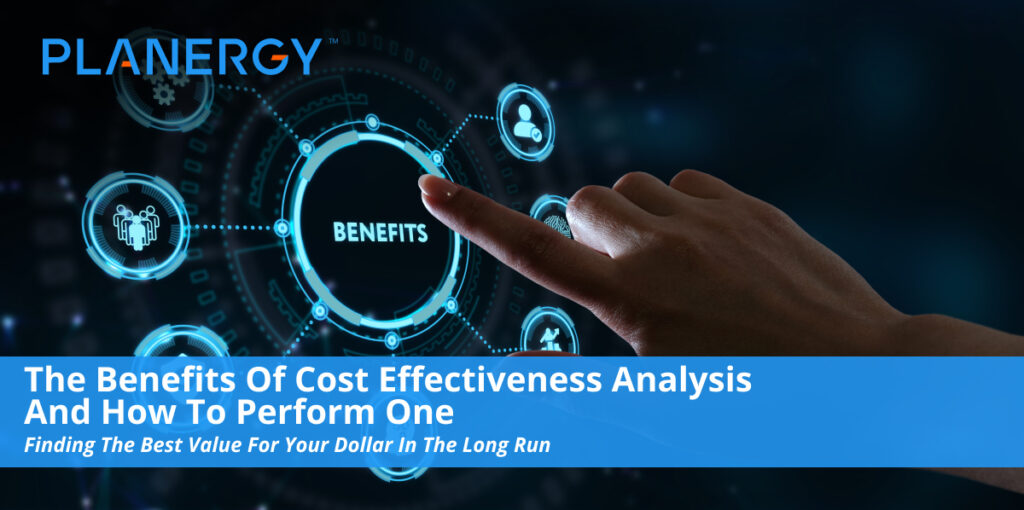Knowing how much value you’re getting for your proverbial buck is an essential part of effective procurement and financial planning. But if you’ve been relying on return on investment (ROI) alone when considering your spend (i.e., cost efficiency), you’re likely missing out on powerful financial insights you need to grow, innovate, and compete.
Cost effectiveness analysis (CEA) is a method of process and economic analysis that serves as a complement to traditional cost-benefit analysis. It improves decision making, resource allocation, and operational optimization.
Understanding its methodologies and the different ways in which you can apply the insights collected can help any organization strike a much-needed balance between cost efficiency and cost effectiveness—and make it easier to survive and thrive in a complex and constantly-changing global economy.
What is a Cost Effectiveness Analysis?
Sometimes called cost utility analysis, a cost effective analysis is one performed to compare the relative costs involved in achieving identical outcomes from different activities. This method is used in a variety of different applications, including but not limited to:
Marketing
Where metrics are used in determining the long-term value of marketing initiatives. Examples include testing the conversion rates for different campaigns, customers completing purchases vs. abandoned carts, impact on long-term growth based on online versus offline initiatives, etc.
Marketers are increasingly leveraging CEA to balance the value created by “upper funnel” tasks such as brand building with the hard-coin ROI from “lower funnel” tasks of converting potential buyers into paying customers.Purchasing
Where CEA is applied to improve decision making and select goods and services that deliver optimal results. In some cases, a slightly more expensive option may provide substantially greater performance, longevity, sustainability, etc. and therefore be a more valuable and intelligent purchase despite its higher relative cost. The most effective purchase is one that considers the immediate and the long-term, as well as the concrete (e.g., profitability) and the intangible (long-term value from more sustainable materials, greater market share due to the use of those materials, etc.).
Health and Medicine
Where CEA helps inform health policy, provide payers with maximum value through lower TCO and higher ROI, and ensure effective asset allocation for different health services. The World Health Organization (WHO) has been engaging in CEA since the late ’90s. Its WHO-CHOICE program seeks to help governments and organizations leverage digital platforms to conduct systematic reviews of potential activities and optimize the efficacy of different health interventions in promoting a healthy life.
In the health services arena, CEA can include economic evaluation of different interventions, but it looks beyond monetary value. It also considers the health benefits of clinical trials, the efficacy of different health care interventions as compared to taking no action, and the impact of different health interventions and their outcomes (i.e., associated health effects) on quality of life (as measured in quality-adjusted life years (QALY)) over the patient’s total years of life remaining.
A more advanced example of a CEA metric being used in health economics is incremental cost-effectiveness ratio (ICER). This metric is used to evaluate the change in relative costs and “units of health” as the effects of a given health care intervention change. Generally, this concerns how many additional life years (i.e., QALYs) are created based on additional spend.Energy Efficiency Studies
, where “negawatts” express the energy that is not consumed due to investment in energy efficient technologies or practices.
Cost effectiveness analysis is sometimes confused with a cost-benefit analysis, but actually fulfills a different function. The outcomes of cost-benefit analyses are generally rendered in per-dollar values comparing the cost of action relative to the cost of inaction.
For example, an organization determines both the average cost to vaccinate a single adult and the total average cost of treating a single case of COVID-19.
Knowing these values helps organizations establish a return on investment (ROI) for every dollar they spend on a given activity (e.g., every dollar spent on vaccination saves $10 in ongoing medical care costs for treating coronavirus patients).
A cost effectiveness analysis, while also generally having outcomes rendered in dollars, is designed to help organizations establish costs relative to one another, rather than a direct ROI per dollar spent.
So if a local government runs two campaigns to encourage vaccination—one using targeted YouTube ads and another using direct contact from a medical professional, for example—they can compare the costs generated by each program and determine the relative cost involved in convincing a single individual to receive a vaccination.
In cost effectiveness analysis, the final decision made won’t necessarily be the cheapest. Rather, by considering multiple dimensions and their impact on a given course of action, CEA seeks to provide a solution that achieves the greatest value, e.g. total cost of ownership (TCO), more years of life for patients, etc.
In order to provide the greatest possible value, CEA requires a willingness to embrace complexity and invest in the data management and analysis tools required to fully explore the different factors affecting the total value of an intervention, as well as the potential for future value creation and more effective cost management.
How to Perform a Cost Effectiveness Analysis
By combining proactive data management with process automation and business analytics, business intelligence provides a foundation for several key improvements within any organization, including:
1. Select an Outcome for Comparison
In order for the results of your analysis to be meaningful, you need to choose criteria you can use to compare and evaluate outcomes. The metrics you choose should be:
- Every activity must be held to the same standards and viewed through the same lens. An “apples and oranges” approach won’t provide useful data.
- Choose criteria you can quantify and readily evaluate. For example, number of widgets manufactured, number of customers who leave items in an online cart, number of boxes shipped, etc.
- Clearly Defined. Clear and firm parameters provide the data restraints necessary to ensure consistency and measurability. So if your metric is, for example, “the number of people cured of Disease X,” and you have two different interventions—Intervention A, administering Vaccine 1, and Intervention B, administering Vaccine 2—you’ll need to address questions such as, “How many shots does each vaccine take? For multiple doses, what if some people only take one of the doses and not the other?”, etc.
To give another example, a firm measuring the impact of two different marketing campaigns—one digital, one traditional—would have to consider different parameters, such as the number of exposures within a given time period and response time compared to initial exposure.
2. Measure Your Selected Outcome
Let’s explore an example of CEA using health economics. A drug manufacturer, BobCo, is using CEA to evaluate two different cures for a given disease (Disease X).
Our chosen metric is the cost effectiveness of administering each of these two treatments to cure Disease X in patients who were treated and then monitored over the course of a month.
To begin our analysis, we need three groups establishing the health outcomes for each intervention:
- A control group who received neither treatment.
- Patients administered Pharmaceutical A.
- Patients administered Pharmaceutical B.
Let’s say each group consists of 100 patients total.
In the control group, 17 patients recovered from Disease X by the end of the control period.
In group 2, 39 patients were cured of Disease X by the end of the control period.
In group 3, 78 patients were cured of Disease X by the end of the control period.
Patients Cured (Control Group) | Patients Cured (Group 1) | Patients Cured (Group 2) |
17/100 | 39/100 | 78/100 |
Difference Compared to Control Group: | 22 | 61 |
With some simple math, we can establish the health gain provided by each intervention. After subtracting the control value for each group, 22 extra patients were cured within the same time period after receiving Pharmaceutical A, and 61 extra patients were cured within the same period after receiving Pharmaceutical B.
Cost Calculations
Now that we have a clear understanding of how each different intervention affected the outcome, we can calculate the cost-effectiveness ratio for each. During this step, be sure to account for every expense associated with each intervention.
Expense | Pharmaceutical A | Pharmaceutical B |
Staff | 2 full-time staff: $3,000 | 1 full-time staff: $3,000 |
Transportation | Fuel for mobile lab: $2500 | None (administered by partner physicians at clinical practice) |
Equipment | PPE, medical supplies, etc.: $3,700 | PPE, medical supplies, etc.: $4,200 |
Administrative | Office supplies, form printing, etc.: $750 | Office supplies, form printing, etc.: $800 |
Total: | $9,950 | $8,000 |
Calculate Cost Effectiveness
To find the cost-effectiveness ratio for each intervention, we simply divide the total costs for each activity (the numerator) by the measured outcome (the denominator).
Pharmaceutical A:
$9,950 ÷ 22 additional patients cured = $453.28 per additional patient cured.
Pharmaceutical B:
$8,000 ÷ 61 additional patients cured = $131.15 per additional patient cured.
In our example, Pharmaceutical B was more cost-effective than Pharmaceutical A, curing more patients at a lower cost in the same time period.
Potential Complications and Limitations of CEA
Basic CEA like the one in our example is extremely useful in the direct comparison of different interventions with identical outcomes (and therefore very useful in tying a given metric to a specific dollar amount). However, you’ll almost certainly need additional analyses, with different metrics, to develop a complete understanding of all the factors involved.
Let’s consider a few different scenarios. Say that, while Pharmaceutical B’s per-patient cure cost effectiveness ratio is substantially better than Pharmaceutical A’s, its primary ingredient is manufactured in a country with very lax worker protection laws and environmental controls. Choosing to use it could increase the company’s risk exposure and damage its reputation with customers, other suppliers, and potential partners.
Alternatively, let’s say Pharmaceutical B had a higher initial per-patient cost, but investment in renewable resources from local suppliers would, over time, improve both sustainability and per-patient cost.
Such investment would also create additional local jobs, generate goodwill in the community, and lead to greater savings and value by allowing BobCo to create some strategic sourcing partnerships and leverage economies of scale.
It also has ancillary benefits (e.g., lowering the patients’ cholesterol) that have a positive effect on QALYs and encourage its widespread approval for other treatments.
This combination of soft and hard value might make Pharmaceutical B the more attractive choice despite a smaller short-term ROI.
Cost-effectiveness studies are about more than simple economic evaluation. Beyond value measured in monetary terms, it’s about strategic, context-savvy decision-making.
Identifying the necessary trade-offs and controlling intervention costs requires the ability (and tools) to conduct systematic reviews of potential activities and their outcomes—and synthesize cohesive insights that guide resource allocation, capital investment, policy changes, etc.
In order to provide the greatest possible value, CEA requires a willingness to embrace complexity and invest in the data management and analysis tools required to fully explore the different factors affecting the total value of an intervention, as well as the potential for future value creation and more effective cost management.
Digital Data Management Helps You Get the Most from CEA
Whether you’re part of the health care system, working in procurement, or developing a killer marketing strategy, your effective interventions will be much easier to achieve with help from advanced digital tools.
A comprehensive, centralized software solution such as PLANERGY provides you with the process automation, data analysis, and artificial intelligence capabilities needed to explore cost effectiveness for a single intervention in multiple dimensions, using multiple metrics, on demand.
Centralizing data management provides a rich, robust, and interconnected datasphere drawing from diverse sources to provide optimal context and clarity. It eliminates common challenges that can hamper CEA, including data opacity, data silos, and methodological inconsistency. And process automation and artificial intelligence provide speed, accuracy, and versatility manual processes and workflows simply cannot match.
Seize New Opportunities to Create Value with Cost Effectiveness Analysis
From helping policy makers improve public health with more effective disease control to giving corporate buyers the insights they need to lower TCO and boost ROI, cost-effectiveness analysis is an essential toolkit for anyone competing in today’s data-driven marketplace.
By understanding its capabilities and limitations, your decision makers can gain invaluable insights they need to improve processes, expand market penetration, and shift away from relying solely on cost management and toward value creation and cultivation.




